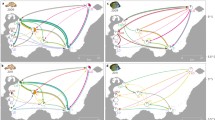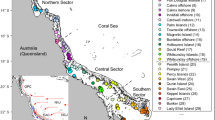Abstract
Numerical models capable of simulating the hydrodynamics associated with large assemblages of reefs are applied to the larval dispersal of Acanthaster planci. Larval distributions which result from passive transportation have been simulated and the resulting patterns of dispersal are compared with the distribution of adults and the observed pattern of Acanthaster population spread. Three forms of asymmetry in reef connectivity are identified within the southern portion of the Cairns Section of the Great Barrier Reef Marine Park. They confirm that larval dispersal within the region cannot be considered as an istropic random process and the recruitment of reefs is not from a homogeneous larval pool. The three forms of asymmetry in the transport of larvae, together with the the longshore currents within the main lagoon, provide a mechanism which results in the passive concentration of larvae adjacent to reefs that border the main lagoon. The three forms of asymmetry are able to account for: (1) the apparent southward spread of Acanthaster populations; (2) the high incidence of “outbreaks” on mid-shelf reefs; and (3) the susceptibility of particular reefs to repeated recruitment. The high incidence of outbreaks on the inner matrix reefs bordering the main lagoon can be explained as a purely physical phenomenon.
Similar content being viewed by others
References
Andrews JC (1983) Water masses, nutrient levels and seasonal drift on the Outer Central Shelf (Great Barrier Reef). Aust J Mar Freshwater Res 34:821–834
Australian Institute of Marine Science (1985) An assessment of the distribution and effects of the starfish Acanthaster planci(L.) on the Great Barrier Reef: 6. Cairns sector
Barnes JH (1966) The crown of thorns starfish as a destroyer of corals. Aust Nat History 15:257–261
Barnes J, Endean R (1964) A dangerous starfish — Acanthaster planci (Linne). Med J Aust 1:592
Black KP (1988) The relationship of reef hydrodynamics to variations in the freeborne larval numbers on and around coral reefs. Proc 6th Int Coral Reef Symp 2:125–130
Bull G (1986) Distribution and abundance of coral plankton. Coral Reefs 4:197–200
Cameron AM, Endean R (1982) Renewed population outbreaks of a rare and specialized carnivore (the starfish Acanthaster planci) in a complex high-diversity system (the Great Barrier Reef). Proc 4th Int Coral Reef Symp 2:593–596
Cresswell GR, Greig MA (1978) Currents and water properties in the North-central Great Barrier Reef during the south-east trade wind season. Aust J Mar Freshwater Res 29:345–353
Dight IJ, James MK, Bode L (1988) Models of larval dispersal within the central Great Barrier Reef: patterns of connectivity and their implications for species distributions. Proc 6th Int Coral Reef Symp 3:217–224
Dight IJ, Bode L, James MK (1990) Modelling the larval dispersal of Acanthaster planci. I. Large scale hydrodynamics, Cairns Section, Great Barrier Reef Marine Park. Coral Reefs 9:115–123
Done TJ (1982) Patterns in the distribution of coral communities across the central Great Barrier Reef. Coral Reefs 1:95–107
Emlet RB (1986) Larval production, dispersal, and growth in a fjord: a case study on larvae of the sand dollar Dendraster excentricus. Mar Ecol Prog Ser 31:245–254
Endean R (1974) Acanthaster planci on the great Barrier Reef. Proc 2nd Int Coral Reef Symp 1:563–576
Endean R (1982) Crown-of-thorns starfish on the Great Barrier Reef. Endeavour (Oxf) 6:10–14
Endean R, Stablum W (1973) A study of some aspects of the crown-of-thorns starfish (Acanthaster planci) infestations of reefs of Australia's Great Barrier Reef. Atoll Res Bull 167:1–62
Great Barrier Marine Park Authority (1985) The crown of thorns starfish. Reflections 15:6–7
Hamner WM, Jones MS, Carlton JH, Hauri IR, Williams DMcB (1988) Zooplankton, planktivorous fish, and water currents on a windward reef face: Great Barrier Reef, Australia. Bull Mar Sci 42:459–479
Harriott VJ, Fisk DA (1988) Recruitment patterns of scleractinian corals: a study of three reefs. Aust J Mar Freshwater Res 39:409–416
Kenchington RA (1977) Growth and recruitment of Acanthaster planci (L.) on the Great Barrier Reef. Biol Conserv 11:103–118
Kenchington RA, Morton B (1976) Two surveys of the crown of thorns starfish over a section of the Great Barrier Reef: report to the Steering Committee for the crown of thorns survey. Aust Gov Publ Service, Canberra, pp 186
Kenchington RA, Pearson R (1982) Crown of thorns starfish on the Great Barrier Reef: A situation report. Proc 4th Int Coral Reef Symp 2:597–600
Lucas JS (1973) Reproductive and larval biology of Acanthaster planci(L.) in Great Barrier Reef waters. Micronesica 9:197–293
Moran PJ (1986) The Acanthaster phenomenon. Oceanogr Mr Biol Ann Rev 24:379–480
Nash W, Zell LD (1982) Acanthaster on the Great Barrier Reef: distribution on five transects between 14°S and 18°S. Proc 4th Int Coral Reef Symp 2:601–605
Oliver JK, Willis BL (1987) Coral-spawn slicks in the Great Barrier Reef: preliminary observations. Mar Biol 94:521–529
Olson RR (1987) In situ culturing as a test of the larval starvation hypothesis for the crown-of-thorns starfish, Acanthaster planci. Limnol Oceanogr 32:895–904
Pearson RG (1972) Changes in distribution of Acanthaster planci populations on the Great Barrier Reef. Nature 237:175–176
Pearson RG, Endean R (1969) A preliminary study of the coral predator Acanthaster planci(L.) (Asteroidea) on the Great Barrier Reef. Qld Dept Harbours and Marine, Fisheries Notes 3:27–55
Sale PF, Douglas WA, Doherty PJ (1984) Choice of microhabitats by coral reef fishes at settlement. Coral Reefs 3:91–99
Sobey RJ, Harper BA, Stark KP (1977) Numerical simulation of tropical cyclone storm surge. Research Bulletin CS14, Dept Civil and Systems Engineering, James Cook University of North Queensland, Townsville
Williams DMcB, Hatcher AI (1983) Structure of fish communities on outer slopes of inshore, mid-shelf and outer shelf reefs of the Great Barrier Reef. Mar Ecol Prog Ser 10:239–250
Williams DMcB, Wolanski E, Andrews JC (1984) Transport mechanisms and the potential movement of planktonic larvae in the central region of the Great Barrier Reef. Coral Reefs 3:229–236
Wolanski E, Burrage D, King B (1989) Trapping and dispersion of coral eggs around Bowden Reef, Great Barrier Reef, following mass coral spawning. Cont Shelf Res 9:479–496
Yamaguchi M (1973) Recruitment of coral reef asteroids, with emphasis on Acanthaster planci(L.). Micronesica 9(2):207–212
Yamaguchi M (1985) Acanthaster planci infestations of reefs and coral assemblages in Japan: a retrospective analysis of control efforts. Coral Reefs 5:23–30
Author information
Authors and Affiliations
Rights and permissions
About this article
Cite this article
Dight, I.J., James, M.K. & Bode, L. Modelling the larval dispersal of Acanthaster planci . Coral Reefs 9, 125–134 (1990). https://doi.org/10.1007/BF00258224
Received:
Issue Date:
DOI: https://doi.org/10.1007/BF00258224




